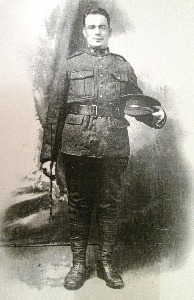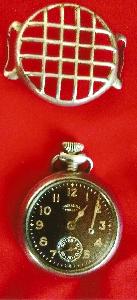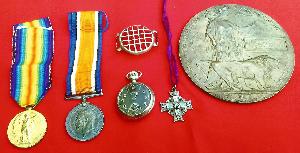
Photo : Derek Armstrong with Thanks
Nicholas Armstrong, Edward's Father

Unknown Newspaper article

Edward's Pocket Watch

Medals, Memorial Cross, Watch, Death Penny
Edward Armstrong ("Scotty"), was born on the 25th December 1886, at 27 Lambert Square, Coxlodge, Gosforth, Newcastle-upon-Tyne, to Nicholas Armstrong, born March 1860, a General Cartman, and his wife Elizabeth J. Barber, [Liz], born 1860, Swalwell, (her father was called Francis born 1828, and her mother was Margaret, born 1835), they were married in 1884, he was the third eldest boy of 13 children, Nicholas Walter, born 12th April 1883, married Mary (Lizzie), Elizabeth, born 29th January 1886, in 1907, became a Naturalised United States citizen. She embarked at Glasgow, and arrived in the USA aboard the S.S. Cameronia, 129599, on the 4th February 1912. Nicholas Walter had also enlisted into the Canadian forces. Robert Rutherford Balmer, born 22nd September 1884, [died 1961], he married Annie Maughan, [born January 1879 in Gateshead, baptised 5th February 1879, Christ Church, Gateshead, Durham, England], in September 1907, [they had three children in 10 years], moving to the USA on the 26th July 1909, aboard the S.S. Californian, 115243, they resided in Washington, Pennsylvania, USA. [One of her sons Stanley was born 23rd March 1908 ], Elizabeth, born 1889, married in 1906 to a Robert Nesbit, [they had 10 children 5 boys and 5 girls]. Isabella, born March 1891, all the above were born in Gosforth. Thomas, the youngest boy, born 18th March 1893, Birtley, [he married Annie E, born 17th April 1900, and had one son Arthur J. born 24th February 1925, in 1939 they were all residing at 42 Irton Street, Gosforth, Thomas was a Motor Driver, Heavy Worker involved in Rescue and Demolition work for Gosforth Urban District Council], Mary Ann, born 1899, again at Birtley, Harriett, born Gosforth 1903, Ethel, born Gosforth, 26th December 1906, and Emily born Gosforth, 1908. However, three other children had died.
In 1891, when Isabella was born a Nurse Isabella Balmer was attending to the baby and mother at 27 Lambert Square, Coxlodge, Gosforth. Edward's mother was Elizabeth Balmer which was also in Robert Rutherford's name, was this a family relation?.
Nicholas Armstrong Senior, (see photo) [Edward's father], was born to Nicholas Elliott Armstrong, born Ryton, in 1816, who was married to Elizabeth, [nee Knox], born 1820 in Benton. He was the second eldest of a family of six, brother Thomas, born 1850, Nicholas born March 1860, Edward, born 1850 and Mary born 1845. he was widowed by 1881 as his wife passed away after 1871.
By 1901, the family, had moved to 27 Maryagnes? Street, Coxlodge, Gosforth, Nicholas Walter, Robert Rutherford, Edward and their father were all working at Coxlodge Colliery.
By 1911, the parents and 5 daughters Emily, Ethel, Harriet Mary Ann, Isabella and Thomas the youngest son were now residing at Zion Cottage, Armstrong Street, Coxlodge, Gosforth.
Edward Armstrong married Ellen Short in 1908, [born 9th June 1887, Jarrow, died 1980 aged 93], and were now residing at 4 South Cross Street, Gosforth, with newly born John Robert born 23rd March 1909. [John Robert worked for the N. E. Electric Company as a clerk, and in WW2, he was an A.R.P. warden. He was married to E. M. Doris, born 3rd February 1911, and they were residing at 218 Whickham Drive, Newcastle-upon-Tyne in 1939].
Edward was a builder contractor for Gosforth Urban District Council. On January the 26th 1912, Edward was given a written reference stating, He was a Good Horseman, Trustworthy, Civil and Hardworking. Signed T. B. Bennett. The Inspector of Nuisances.
Edward emigrated to the USA on the SS Cameronia, 129599, departing Liverpool, and arriving at New York on the 4th February 1912, his elder brother Nicholas Walter also had emigrated to the USA. He went on to became a Naturalised USA Citizen in Pennsylvania.
Edward's wife Ellen and 2 children came over on the R.M.S. Mauretania, 124093, Cunard Line, departing from Liverpool on the 31st August 1912, with John [born 20th March 1904], age 3 and Wilfred George [born 15th June 1911, died December 1997], aged 1, and arriving on the 6th September 1912.
They were residing at 506 Railroad Street, Monongahela, Pennsylvania, and Edward was employed by the Pennsylvania Railroad Company at Monongahela Station, as a Car Inspector at Elrama. Nicholas Walter also was residing at this address, he also was a Car Inspector. Nicholas Walter was married to Mary Elizabeth and they had two children, Walter and Donald.
Nicholas Walter was in the Northumberland Hussars Yeomanry as a Corporal for about 3 years and then in the Durham Cyclist Unit, before he emigrated to the USA. When he attested on the 24th April 1918, he stated his address as 506 Railroad Street, Monongahela, Pa. USA. [The same address as his Brother Edward]. He was 5 feet 2 and three-quarters inches high, a Fair Complexion, Grey eyes and Brown Hair. Age 35 Years. Scars Right shoulder and Hand. He wore glasses. Weight 128 lbs.
He passed his Medical at Toronto on the 24th April 1918. His service nu was 2500368, his rank was sapper, and was in the 40th Draft Railway Construction Battalion. He embarked for England on the 20th June 1918 aboard the H.M.T. Waimana, disembarking on the 7th July 1918.
10,389 gross tons. Lb: 478 x 63 feet (145.6 x 19.2 metres). Passenger steamship built by Workman Clark, Belfast for Shaw Savill & Albion. Twin screw, triple expansion engine making 13 knots.
Was based at Purfleet, before proceeding overseas on the 3rd September 1918 to be transferred to the 7th Battalion Canadian Railway Troops. Walter arrived in the field on the 5th September 1918 where he joined his unit. On the 26th January he was transferred to England for the purpose of being demobilised, and was based at Knotty Ash near Liverpool.
Canadian Railway Troops battalions, on arrival in France, came under the command of Brigadier-General J. W. Stewart, a Canadian who was Deputy Director General Transportation (Construction) at British General Headquarters. In March 1917, Stewart established the administrative headquarters of the Canadian Railway Troops at General Headquarters. It was not connected with the Canadian Corps. Reorganized effective on the 23rd April 1918, and redesignated as the Corps of Canadian Railway troops. Composed of Headquarters Canadian Railway Troops Services in England, Canadian Railway Troops Depot (organized at Purfleet, Essex late in 1916), 1 -13 battalions Canadian Railway Troops, No. 13 Operating Company Light Railway, No. 58 Operating company Broad Gauge Railway, No. 69 Wagon Erecting Company, No. 85 Engine Crew Company and the Canadian Overseas Railway Construction Corps. Disbanded by General Order 196 of 1 November 1920.
Source : Canadian Railway Troops
Walter travelled on the H.M.T.S. Empress of Britain, 120940, before being struck of strength on the 1st April 1919.
After the War Walter made a few trips to England, on the R.M.S. Aquitania, 147318, 3rd Class, departed New York, arrived at Liverpool on the 5th August 1935, staying at 77 Denmark Street, Heaton, Newcastle-upon-Tyne. Then returned on the R.M.S. Laconia, 145925, on the 31st August 1935, accompanied by his wife and the two boys Walter and Donald. Then on the R.M.S. Queen Mary, 164282, with his wife, now aged 66, both retired this time, staying at 417 Shields Road, Heaton, Newcastle-upon-Tyne, arriving on the 19th May 1952. His wife also travelled, Mary Elizabeth with their son Walter then aged 4, were leaving on the M.V.Britannic, 162316, from Liverpool to New York on the 27th September 1930 after staying at 77 Denmark Street, Heaton, Newcastle-upon-Tyne.
Edward received a '12 question' first USA Draft Registration Card. [So called because of 12 questions on the front].
In 1917 and 1918, approximately 24 million men living in the United States completed a World War I draft registration card. That accounts for approximately 98 percent of men in the U.S. born between 1872 and 1900. The total U.S. population in 1917-1918 was about 100 million individuals, so close to 25 percent of the total population is represented in these records.
The World War I draft consisted of three separate registrations. First Registration. The registration on the 5th June 1917, was for men aged twenty-one to thirty-oneómen born between the 6th June 1886 and the 5th June 1896. Second Registration. The registration on the 5th June 1918, was for men who had turned twenty-one years of age since the previous registrationómen born between the 6th June 1896 and the 5th June 1897. Men who had not previously registered and were not already in the military also registered. In addition, a supplemental registration on the 24th August 1918, was for men who turned twenty-one years of age since the 5th June 1918. Third Registration. The registration on the 12th Sept 1918, was for men aged eighteen to twenty-one and thirty-one to forty-fiveómen born between the 11th September 1872 and the 12th September 1900.
His parents in the UK had now moved to 23 Simonside View, Gosforth, Newcastle-upon-Tyne.
Ellen had returned to the UK with the children, by May 1918, and was now residing at 86 Helen Street, Benwell, Newcastle-upon-Tyne. They had four children, John Robert born 23rd March 1909, he died in June 1999 at the age of 90, Wilfred George Armstrong, born 15th June 1911, died December 1997, Nellie Armstrong was born in 1916, she lost her father when she was only 2 years old and Edward [Eddie] Armstrong was born in January 1919?, he died in 1996 at the age of 77.
Edward crossed the USA border to enlist for the Duration of the War, in to the Canadian Army in November. He joined up on the 3rd December 1917 at Toronto, Canada. Service Number 3105848, and was attested into the 1st Section, 1st Depot Central Ontario Regiment, Class A2, his personal details were described as age 30 years 11 months, 5 feet 6 inches high, dark complexion, brown eyes, and brown hair. He also had bad teeth, and had a scar on left cheek, Birthmark on left ear with scars on both shins. Weight 154 lbs.
Edward embarked at Halifax in Canada on the 3rd February 1918. He arrived in England at Liverpool aboard the SS Scandinavian on the 16th February 1918. He was in the 8th Reserve Battalion, taken off the strength from the 1st Depot Central Ontario Regiment. On the 19th May 1918, he was transferred to the Canadian Machine Gun Depot at Witley. Then into the Machine Gun Pool at Seaford, Sussex, until the 18th August 1918. On the 19th August he arrived in France and was taken off strength of the Canadian Machine-Gun Pool. Edward then was posted to the 4th Machine Gun Battalion in the field arriving on the 25th August 1918. He joined his unit on the 28th August 1918.
The formation of the Canadian Machine Gun companies was authorised on the 29th October 1915. The companies initially took their names from the Brigades to which they were attached.
Edward was in the 4th Machine-Gun Battalion in the 4th Canadian Division. "During the afternoon of September 1st, and the evening the enemy delivered heavy counter attacks against the junction of the 1st and 4th Canadian Divisions and twice our troops gave way slightly but regained the ground at once. The hand-to-hand fighting for the crest continued until actual zero hour for the attack. 'E' Battery, in support of the 12th Battalion fired ten belts with good effect as one of these evening attacks was launched at the 72nd Battalion."
"At 5am the attack swept forward for the formidable Drocourt-Queant line and, although in recent days attacks had been battered down to the crawl almost of set-piece attacks, the Corps' vision was still trained into the distance. There were no limits set but there were three definite objectives aimed at and the capture of these would carry the attack over 6000 more yards and over three separate lines of trenches in addition to the frowning Drocourt-Queant system."
"The 4th Division shoved forward about noon and as the advancing units, widely extended , pushed their way slowly down the green slopes from the Dury ridge they came under scattered but heavy artillery fire and, as they neared the West bank of the Canal, intense machine-gun fire".
Edward was killed at about 1.20 pm whilst resting in a house with fellow soldiers by an artillery shell which exploded on the house they were resting in. His watch [which is still in the possession of the family], was the only thing that the Canadian Medical Team could retrieve from him.
The Unknown newspaper article above reads :
Private Edward Armstrong, better known as "Scotty" aged 31 years, son of Nicholas and Elizabeth Armstrong, of 23 Simonside View, Gosforth, England, killed in action Sept 2nd, according to official information received here by Mrs Walter Armstrong, a sister-in-law.
Mr Armstrong before enlisting last November was employed by the P. R. R. in Elrama, where he had made a host of friends there and in this city. Mr Armstrong leaves a wife and three children in England.
The three brothers has brought a farm near Elrama, and after the War the surviving brothers continued to run the farm.
Edward left a Will in which he bequeathed all of his property and monies to his wife Ellen, who also received a War Gratuity of $100. This will was witnessed by Lieutenant Fred H. Duck.
Edwards parents have moved now to 199 Salters Road, Gosforth, Newcastle-upon-Tyne.
Source: The Emma Gees Lt-Col C.S. Grafton V.D. 1938. Published by The Canadian Machine Gun Corps Association.
Edward Armstrong is remembered in Gosforth on G9.21 and in the Canadian Book of Remembrance, page 306
War Diary entry for the 2nd September 1918
Canadian Machine Gun Battalions
Canadian First World War Book of Remembrance.
The CWGC entry for Private Armstrong

